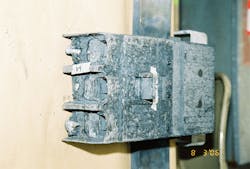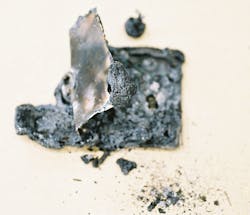For one electrician, the day began with a routine service call to troubleshoot electrical problems at a major department store in town. It ended with one person injured, two people dead, significant property damage to the facility, and serious lessons for anyone who works on electrical systems.
The Scene
The store was located in a large mall facility with an electrical system that was 480V, 4-wire with 277V from each phase to ground. Earlier in the day, the store had experienced several short power outages and erratic behavior of its HVAC system computer. After store personnel observed smoke coming from an emergency lighting box on the second floor, they called their maintenance department, who immediately disconnected the emergency circuit by shutting off the circuit breaker. A maintenance worker then called the electric utility to inspect the incoming service. Upon investigation, utility personnel concluded that the problem stemmed from inside the building. Based on this conclusion, the store called a local electrical contractor to come out and troubleshoot the system.
The electrician from this firm had been to the shopping mall location several times in the past, so he was familiar with the facility. He planned to stop there on his way back to the shop, after supervising work at a different job site. Because the call was unexpected and not on his schedule, he didn't have his tools or test equipment with him. However, he knew the store's maintenance department would have the tools he needed on hand.
It was raining that day, with thunderstorms and lightning in the area. An electric utility crew was at a nearby underground vault dealing with a transformer fire. One of the utility workers commented to a witness that someone had accidently crossed two phases somewhere on the system, which had caused major problems, as several stores in the mall reportedly had experienced blackouts.
The Accident
The electrician arrived at the retail store only to find that the fire department was already there, due to the smoke and power outages. Borrowing a multimeter from the maintenance department, the electrician checked several routine things and then removed the cover from the emergency lighting circuit breaker in the main 480V switchboard. On one side of him stood a store maintenance employee; on the other side was a high-ranking fire department official. He promptly began checking voltages on the line side lugs by measuring from each phase to a ground point on the box. For reasons we will never know, after checking all three phases, he made a comment to the effect that something was not right — and returned to the center lug a second time. As he made this measurement, a fireball erupted from the panel, severely burning all three individuals and causing significant damage to the electrical equipment and surrounding area. Although witnesses and medical professionals provided rapid response and assistance, the injuries proved fatal for the electrician and the fire official.
In the aftermath of the accident, various parties filed lawsuits involving the victims' estates against the electrical contractor, store, meter manufacturer, and insurance companies. In an attempt to recover some of the substantial cost of the insurance claim, the attorney for the store's insurance company retained my services as a forensic engineer to investigate the incident and provide opinions on the cause of the store damage.
The Investigation
Because several years had elapsed since the accident had occurred, I did not inspect the actual site. However, I did study photos of the scene taken immediately following the incident. I also examined artifacts from the scene that had been in storage, including the circuit breaker and multimeter; studied hundreds of pages of reports, photographs, and deposition transcripts; and performed independent research in order to develop my opinions. Following are the results of my investigation.
Facility problems — Inspection of the store's electrical system by another electrical contractor after the accident showed a section of damaged wiring in the emergency lighting circuit as well as problems with the backup generator — problems that were repaired prior to reopening the store. Obviously, the electrical system issues prompted the service call; however, none of the evidence connected any of these factors with the arc flash event.
Multimeter — The multimeter was the subject of considerable investigation. It was an analog instrument designed to measure up to 1,000V, advertised on the box as an “industrial multimeter.” It did not have an International Electrotechnical Commission (IEC) safety rating, although that rating system was well accepted at the time of the accident. Meters used for 480V industrial work require a minimum IEC 600V CAT III rating. The test criteria for this rating would ensure that the instrument could withstand a 6,000V impulse with 3,000A of available short-circuit current. An engineer from the manufacturer testified that his firm had never tested that model instrument at the IEC test conditions — or even at its maximum working voltage rating.
We obtained an identical exemplar meter for study and comparison. Evaluation of the meter circuit showed that it used a small glass 8AG fuse rated 0.5A at 250V for circuit protection on some functions. According to Underwriters Laboratories, the interrupting capacity of this style of fuse is only 35A at 250V. It has no specified interrupting rating above 250V. An estimate of the fault current through the meter shows that it could have been from several hundred to as much as 1,000A at 277V.
Several locations on the meter circuit board had opposite polarity traces that were much closer than allowed by the 600V CAT III specifications. Arcing across these locations could put current through the fuse circuit.
Training — Although the electrician was an experienced journeyman, he reportedly had not received any formal safety training since his initial union training many years before. Several representatives from the electrical contractor testified that they did not provide any safety training to their employees and had no arc flash personal protective equipment (PPE) available. As a result, the electrician was most likely not familiar with the arc flash safety requirements, test equipment safety ratings, or PPE requirements that existed at the time of the accident.
OSHA — Based on the results of its investigation of this incident, OSHA fined the electrical contractor for multiple training, PPE, and work practice violations.
Sequence of events — The meter suffered an internal failure, most likely due to a voltage transient. Because of the severe damage to the meter and circuit board, it was not possible to determine the precise failure. However, based on the evidence, I concluded that, as a result, the fuse attempted to open the circuit against a fault current and voltage that were far above its design capability. This caused it to arc and ultimately explode, which explains the bent scale plate, housing damage, and missing fuse and clips.
What actually started the arc at the bus bars? Either it resulted from the meter explosion itself or arcing at the probe tip as the electrician instinctively pulled it away in response to the noise and flash. Once the bus bars began to arc, the victims' fates were sealed, as there was no turning back at that point.
Findings
I presented the following opinions in my report and deposition testimony:
- The meter design was defective for making measurements as advertised on industrial electrical systems. It could not withstand the voltage transients present on such systems, and the fuse was unable to interrupt the fault current that resulted from an internal failure.
- The meter manufacturer provided no warnings against using the meter to make measurements on high-energy industrial electrical systems. In fact, the misleading wording on the box implied it was acceptable for this use.
- Several competitive analog meters at the time of the accident contained high interrupting capacity fuses (10,000A at 600V) that could have safely opened the circuit in the same situation. They also had warning statements in their owner's manuals cautioning not to use them to make measurements on high-energy circuits.
- The electrical contractor provided no training for the electrician. As a result, he did not recognize that the meter lacked appropriate safety ratings and was unsuitable for the intended measurement.
- The lack of training also resulted in improper work practices and lack of appropriate PPE. This was not relevant to the question of store damage, because the arc flash still would have occurred. However, it was a major contributor to the injuries and fatalities.
In the end, the lawsuits settled out of court, and the cause of the accident was never officially determined by the legal system.
Lessons Learned
This case should remind even the most experienced electricians that they need to continue their training on an ongoing basis. OSHA regulations and NFPA 70E have undergone extensive changes in recent years to define test equipment safety requirements, arc flash hazard levels, and appropriate PPE, yet accidents such as this still occur far too often.
As this case reminds us, never use any piece of test equipment if you cannot confirm its capabilities or ratings. Read the owner's manual to verify the acceptable use, and note any warnings. In addition, all electricians need to be familiar with the IEC safety ratings for test equipment and how to apply them. Finally, it's important for all of us to remember that there is no such thing as a routine task when working on electrical power systems. Proper training and the use of appropriate procedures, PPE, and test equipment would have undoubtedly produced a far better outcome in this case.
Miller is president of B. Miller Engineering in Deerfield, Ill. You can reach him at [email protected].




